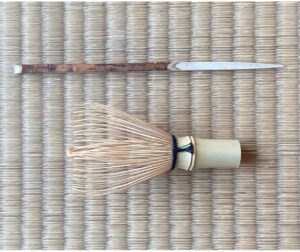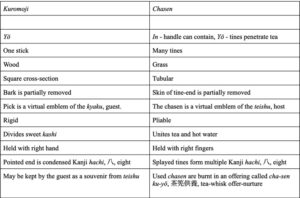Chasen and Kuromoji: In and Yō

All things are In, 陰, Yin, negative, physical. A way to remember this is that the word ‘in’ is part of the word th’in’g. Incorporeal, spirit, emotions, are Yō, 陽, Yang, positive, non-physical. Within the In world, things are divided into In and Yo.
Tea as a shrub, is like all things, In. And as a growing living thing, tea is In. When picked, tea leaves are dried and ‘dead’ which is, Yō. During a Tea gathering, there is a clear representation of In and Yō in the presentation of both the sweet and the tea.
The sweet is relatively solid, and held on flat, cornered paper, Yō. The sweet in generally handled with the Yō utensil, kuro-mo-ji, 黒文字. Black-letter-character.
The tea mixed with hot water with a cha-sen, 茶筅, tea-whisk, a Yō is a liquid held in a three dimensional, round ceramic bowl, the chawan is an In utensil.
The following illustrations show a comparison between the kuromoji used to enjoy the sweet and the chasen used to make the tea.


Specific dimensions are challenged in measuring the different areas of the kuromoji because the knife-cuts are made on the diagonal. Therefore, some of the dimensions given here are approximates.
The length of the kuromoji is 6 sun kane-jaku; the measurement from the point to the area with bark intact is approximately 2.666 sun kane-jaku, areas with bark removed total 2.666 sun kane-jaku, the length of the handle end with bark is 4.444 sun kane-jaku. The ratio between 2.666 and 4.444 sun kane-jaku is 6.666 to infinity :10.
The length of the cha-sen, 茶筅, tea-whisk, is 3 sun kujira-jaku. The measurement between the thread wrapping and end of the handle is 1.2 sun kujira-jaku. The length between the thread wrapping and end of the tines is 1.8 sun kujira-jaku. The ratio between the two measurements is 6.666 to infinity:10. The lengths of the kuromoji and the chasen relate to each other 8:10. The number 18 in Japanese is jū-hachi, 十八, which can be written with the Kanji, moku, 木, tree, which is symbolic of life.

The kuromoji and the chasen may be likened to other things in Japanese culture, and especially in Buddhism. The Vajra or Dorja of Buddhism is a representation of the lightning bolts of Indra, king of the gods. In Japan, he is known as Tai-shaku-ten, 帝釈天, Emperor-explain-heaven (Deva), and in fight with Vritra, the embodiment of drought, removed him with his lightning bolts, and the world came into existence. Variations abound and many Vajra have talons in various arrangements, some of which resemble the chasen. The single pestle Vajra may be identified with the kuromoji, which brings life to the guest in the form of the sweet. The Vajra with talons may be identified with the chasen which brings life to the guests in the form of tea.

